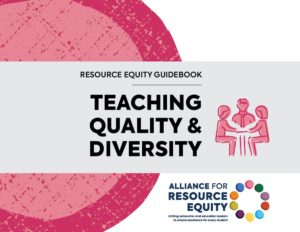The Vision
Each student—including students with higher needs and students of color—gets the combination of high-quality instructional time and teacher attention they need through evidence-based approaches, so all students can reach high standards and thrive.
Sample Questions to Ask
- Do schools in our district have the flexibility to adjust student schedules to differentiate instructional time?
- How does the amount of instructional time spent in core subjects vary by student proficiency level across student groups and/or across schools in our district?
- What is the average class size in our district by grade level and subject area?
- To what extent do average class size vary across proficiency levels, student groups, and/or across schools in our district?
See our DIY District Diagnostic for more examples and recommendations about the types of data to look at.
Take Action With Our Diagnostic Tools
- Use our Resource Equity Diagnostic: Self-Assessment tool to start conversations and build shared understanding across teams.
- Then, analyze your data to better understand the state of resource equity in your district. First, use our Diagnostic Blueprints to learn about what types of analyses to conduct. Then, input your district data into our DIY Analysis Tools to complete these analyses and make meaning of the results.
- Prioritize areas for further inquiry and identify potential root causes and actions using our District Guidebook.
Common Causes of Inequity
- Ineffective Identification Process: Schools that do not consistently use a transparent and unbiased system for identifying and monitoring each student’s academic needs will be unable to differentiate time and attention effectively to meet students’ needs.
- Insufficient Staff Capacity and Supports: When schools do not have sufficient time or staff to meet the needs of all students, it can limit their ability to differentiate instructional time and attention based on student needs.
- Rigid School Scheduling Practices: Districts and schools may struggle to support all students needs when they lack strategic scheduling and staffing approaches – such as intervention and enrichment blocks, longer core subject blocks, small groups, and individual support.
Related Dimensions
No single dimension of education resource equity can unlock every student’s potential—but when dimensions are combined to meet students’ distinct needs, they are a strong foundation for unlocking better, more equitable experiences in school.
Explore the Teaching Quality and Diversity dimension because the benefits of increasing instructional time and attention partially depend on the quality of the instructional practices that are used.
Toolkit
Use our Resource Equity Toolkit to learn more, start a conversation, and take action in your community.

The Education Combination
Learn about education resource equity by discovering 10 dimensions that unlock better, more equitable experiences in school for all students.

Diagnostic Tools And Supports
Identify strengths and gaps in your school system across all 10 dimensions.

Guidebooks
Explore underlying causes of your school system’s challenges and possible actions to improve students’ experiences in school.

Advocating Across Government
Identify who has the power to address equity gaps in your school system and the school district, state and federal levels.

Casemaking Decks
Develop compelling and coherent messaging to “make the case” for addressing resource inequities in your community.
